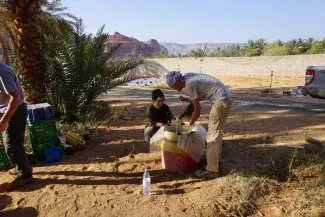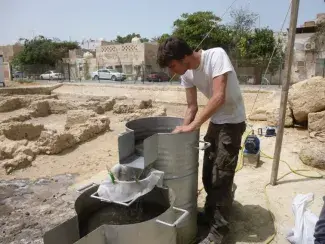
Researcher profile : Vladimir Dabrowski
Vladimir Dabrowski, young postdoctoral researcher from the Jaussen & Savignac programme recruited by CNRS: PROFILE
Vladimir Dabrowski, an archaeobotany (environmental archaeology) researcher joined the Jaussen & Savignac Archaeological Center in February 2025 as a postdoctoral fellow, contributing to one of the six research themes of the Jaussen & Savignac programme on environmental heritage. Now recruited by CNRS, he embodies a new generation of scientists, carrying forward innovative and promising research — a journey we are proud to highlight.
J&S Programme – As you embarked on your academic path, what inspired you to specialize in archaeobotany?
Vladimir Dabrowski – Over the course of my years at university, I developed a strong interest in environmental archaeology, a field taught at Paris 1 Panthéon-Sorbonne since 2005. What I find particularly compelling about archaeology is its position at the interface between the humanities and social sciences, and the natural and exact sciences. Within this field, I was particularly drawn to archaeobotany — the study of plant remains uncovered on archaeological sites — as it initially gave me the opportunity to explore the theme of food. Food has always been central to my family culture, and it remains at the heart of my research interests: as part of our cultural heritage, and for its broader environmental and climate-related implications.
J&S P – Can you share your academic journey and tell us why you became interested in archaeobotany, and specifically in the Arabian Peninsula?
V. D. – My interest in this field developed very early in my studies. During my Master’s in environmental archaeology at Paris 1 Panthéon-Sorbonne, I began working on the Arabian Peninsula following my meeting with Margareta Tengberg, who at the time was a lecturer in archaeobotany at Paris 1. At that time, she offered me the opportunity to conduct a research project on carpological (seeds and fruits) and anthracological (charcoal) remains from a burned structure at Mleiha in the United Arab Emirates, which I chose to accept. Due to the interest generated by my initial results on the trade of exotic products, I went on to pursue my doctoral research on the supply of plant resources to societies in Eastern Arabia, using archaeobotany and archaeentomology. This work was supervised by Margareta Tengberg, who had become a professor at the National Museum of Natural History, and Jean-Pierre Van Staevel, a professor at Paris 1.
Following the defense of my PhD in 2019, I was recruited on two consecutive postdoctoral projects focused on the oasis of Al-Ula in Saudi Arabia, funded by the French Agency for ALULA development (AFALULA) in collaboration with the Royal Commission for AlUla (RCU): the ECO-Seed project (supervisor: Charlène Bouchaud), and then the ArcAgr-AU project (supervised by Louise Purdue). Both of these projects aim to reconstruct the agricultural and environmental dynamics of the Al-Ula oasis by assessing the impact of environmental, climatic, and socio-economic changes. On this occasion, I also trained in the analysis of phytoliths, microscopic silica bodies found in plant tissues from ancient agricultural soils and natural deposits. Their study provides information on the composition and spatial organization of oasis environments, including crop distribution and types of agricultural production.
Following my research on the Al-Ula oasis, I obtained a new research contract with the LabEx DynamiTe at the Laboratory of Physical Geography (LGP), under the supervision of Aline Garnier. I then concentrated on the caravan city of Thaj in Saudi Arabia, the first urban settlement in Eastern Arabia prior to Islam, investigating how an ancient desert city secured its supplies and, in particular, how it sustained population growth despite apparently limited resources.
Following this project, the Jaussen & Savignac programme launched a call for applications, enabling me to continue my archaeobotanical work in the eastern Arabian Peninsula, covering the period from late Antiquity to the early Islamic era.
J&S P – Having spent the past eight months on a postdoctoral contract with the Jaussen & Savignac programme, could you share what specifically drew you to join it?
V.D. – I saw it as an opportunity to work in excellent material and human conditions within a dynamic, stimulating, and supportive research environment. Moreover, my project aligned perfectly with one of the program’s themes, ‘Environmental Heritage: Oasis Landscapes.’ For the past year, I have been investigating, using multi-proxy archaeobotanical approaches, the material reality of the Islamic Agricultural Revolution in the oasis landscapes of Eastern Arabia, a region that remains largely under-documented for this period.

P J&S – You were recruited by CNRS to carry on your research into the interactions between societies and their environments — could you tell us more about this?
V. D. – Indeed, my research project focuses on how ancient and medieval societies adapted to the arid environments of Eastern Arabia in a context of globalized trade. To achieve this, I am using an innovative multi-proxy approach that integrates archaeobotanical remains — including seeds, fruits, charcoal, dry wood, and phytoliths — alongside archaeentomological data (insects).
J&S P – Environmental preservation and tackling climate change are urgent concerns today. Vladimir, do you think that ancient and medieval societies can teach us something as we confront this deep climate crisis?
V. D. – Indeed, these environments are particularly interesting to study in historical periods, as they allow us to understand how societies adapted to arid climates in the acquisition of plant resourcesWe observe that ancient societies consistently sought to optimize available resources. For example, crop residues or manure were commonly reused as fuel. While this practice persists today to a much more limited extent, it was much more systematic in ancient and medieval societies. Regarding oasis management, my research shows that the introduction of new plants within oases could help respond to climatic crises, such as droughts, or significant demographic changes.
J&S P – Does this mean that ancient societies were practicing something like permaculture?
V. D. –I’m not sure we can speak of permaculture for these historical periods, but the analysis of the cultivated biodiversity of these ancient societies provides insights into how they practiced complementarity and the association of multiple species within a rational management of oasis landscapes.
As a discipline bridging the humanities and natural sciences, archaeobotany provides extensive knowledge on multiple facets of plant-based economies in ancient societies, encompassing alimentation, agriculture, craft, commerce, environmental interactions, and funerary and ritual practices.